|
Captain Sir William Peel V.C. K.C.B
|
continued from page 2 ...
The Order of the Bath
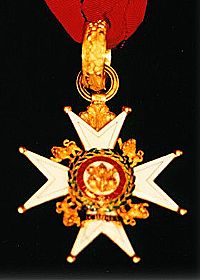
Neck badge
|
As I introduced the talk Captain Sir William Peel V.C. K.C.B. I am sure we all know what the VC stands for but what about the KCB? This indicates that he is a Knight Commander of the Most Honourable Order of the Bath.
King George 1 established this Order in 1725. Its name derives from the long abandoned ceremonial rites, including a ritual bath, used in creating " Knights of the Bath", records for which go back to 1399. The Order of the Bath was from its founding in 1725 primarily a military order until 1847, when Queen Victoria decreed that it be awarded also for civil merit.
The first award, the C.B. or Companion of the Most Honourable Order of the Bath that made him a Knight, was awarded for his services in the Crimea and was gazetted on 5th July 1855. This uses the neck badge (left) that is the same for all classes but comes without a breast badge. His K.C.B. or Knight Commander of the Most Honourable Order of the Bath was gazetted on 21st January 1858 when he was made Aide de Camp to Queen Victoria. Incidentally the expression gazetted comes from the fact that all promotions and awards are published in the "London Gazette".
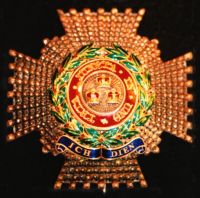
Breast badge
|
The Latin inscription that you see on the order is TRIA JUNCTA IN UNO or three joined in one; the other inscription that you see is familiar to most of you, it is the Prince of Wales's motto in German ICH DIEN or I Serve.
Three joined in one refers to England, Scotland and Ireland, if you look closely at the order you would see the rose of England the thistle of Scotland and the shamrock of Ireland.
It is on record that Lady Hamilton whose husband Sir William Hamilton, ambassador to Naples, possessed the order, commented after Nelson also received this decoration, that her triangular arrangement of the three of them could be referred to as "Tria Juncta in Uno".
|
The Victoria Cross
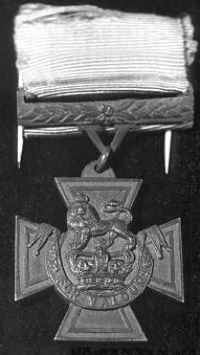
The Victoria Cross
|
Now the VC. The one you see on the left is a replacement, from Messrs. Hancock's & Co., of Vigo Street in London who manufacture them. The crosses are cast, not struck from dies, and then finished by hand. This is why there are several various "different" V.C.'s. This one was made for the Peel family when they presented the original to the National Maritime Museum at Greenwich in 1912. But unlike the original it is not named neither does it have the three dates on it.
It is the foremost British and Commonwealth gallantry decoration, it is awarded for exceptional bravery and as such is the most prized award that any subject can earn.
Prior to the Crimean war there was no recognised gallantry medal, but the individual deeds of heroism in the war made such an award necessary. Consequently, the Victoria Cross was instituted by Royal Warrant dated 29th January 1856, and was made available to officers and men alike. It was deemed by Queen Victoria that the cross should be simple in design and was to be made from a bronze cannon captured during the Crimean War. Victoria's interest in the award was such that she personally invested 62 of the 111 Crimean recipients at a parade in Hyde Park. At one time Navy recipients wore their award from a navy blue riband and the Army from a crimson riband. In 1916 a miniature of the cross was added to the riband so as to make it more distinctive, and in 1918 with advent of the Royal Air Force the crimson riband was adopted for all the Services. The date for which the award was granted is engraved in the centre of the reverse of the cross and the name of the recipient is engraved on the reverse of the suspender.
|
The award is open to civilians, 4 were awarded in the Indian Mutiny, and also to women, but no award has yet been made. The cross has been earned on three occasions in the United Kingdom and to a small number to men of foreign origin. Three cases of both father and son receiving the award are recorded and four known cases to brothers. Perhaps the most outstanding are the three recipients who were awarded a bar to their existing cross.
As VC's are awarded for a single act of gallantry where there should be a 90% chance of death it is little wonder that there have only been three such awards. As William Peel's had three dates engraved on the back of his VC, I would like to suggest that if the warrant that made it possible to win a subsequent award had been in place in Peel's time then he would have had the VC with two bars. Further, as the VC was not awarded posthumously at that time he would have earned, perhaps, another bar for his gallantry in the Indian Mutiny at the Second Relief of Lucknow. The Victoria Cross was sent from the War Office to Hong Kong and thence to India, but by the time it had arrived Peel had already died, whereupon it was posted by a Commodore Watson of HMS ‘Chesapeake’, to Peel’s brother Sir Robert Peel Bt, on 27 June 1858.
To date 1354 Crosses including three, second award bars have been made, this includes one to the American Unknown Soldier but it is interesting to note that this accolade was not awarded to the British Unknown Soldier.
Until 1920 when King George the fifth rescinded that part of the Royal Warrant that allowed the forfeiture of a VC, eight had been forfeited. The first to suffer this "embarrassment" was Edward St John Daniel.
Read more about Edward St John Daniel
Soon after the allied landing in the Crimea and the battle for the Alma started in September 1854, the British C-in-C, Lord Raglan, asked for the assistance of the Navy. On the 1st October, over a thousand bluejackets and officers, with over a thousand marines from the fleet, began to disembark with their guns and equipment at Balaclava. Amongst them were sailors and heavy guns from the 28 gun frigate Diamond, under Peel their Captain. By the 7th the Naval Brigade had constructed and manned two gun batteries facing Sebastopol, mounting 32-pounder, 68-pounder and Lancaster guns from the ships, dragging them by hand up the hillsides from the harbour. The naval guns took part in the great bombardment of Sebastopol that began on 17th October.
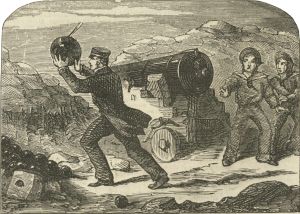 William Peel, Captain, throwing a live shell over the parapet.
William Peel, Captain, throwing a live shell over the parapet.
From the Supplement of "The Illustrated London News" of June 20th 1857
Read the accompanying text ...
|
The next day, the horses drawing the ammunition wagon for the Diamond's battery refused to face the heavy Russian fire. Volunteers went to clear the wagon and bring up the ammunition. Before the powder could be stowed in the magazine a 42-pounder Russian shell with its fuse burning fell in the middle of the powder-cases and the volunteers unloading them. Hearing the shouts of alarm, Peel sprang to the shell, clasped it against his chest and carried it thus until he could throw it over the parapet. The shell burst almost as soon as it left Peel's hands but fortunately no one was injured. The 18th October 1854 then is the first date on his VC. It is interesting to note that in the early days of the siege our men were paid for each Russian shot that they salvaged so that they could be fired back again, obviously that one of Peel's would not have counted!
On 5th November, during the Battle of Inkerman, the Duke of Cambridge with some of his staff and about a hundred men were grouped around the colours of the Grenadier Guards in a place called the Sandbag Battery, which was an emplacement some 30 feet wide with embrasures for two guns. Unknown to them their retreat had been cut off by the enemy, and two more Russian battalions were advancing from their left. Peel saw what was happening through his field glasses and made his way through the smoke and mist to warn the Duke's party. One of the officers later recounted that he noticed that Peel was wearing "a tall glazed hat" and was accompanied by his ADC, Midshipman Daniel, riding a pony! Thanks to Peel's warning the Guardsmen made a strategic withdrawal. The 5th November 1854 then is the second date on his VC.
On the 18th June 1855, the final date on his VC, and the fortieth anniversary of the Battle of Waterloo, the British and French, this time fighting side by side, attempted to take by storm the massive fortress of the Redan at Sebastopol. The attacks were not properly co-ordinated, and the Redan was very strongly defended. The attacker's, amongst whom were many from the Naval Brigade with scaling ladders, had to run some way across open ground under heavy fire. There were many casualties among the bluejackets, and Peel, who had led the first scaling party to the very foot of the Redan wall, was himself hit and severely wounded in the arm. He was led back, half fainting with loss of blood, by Daniel who, according to Midshipman Evelyn Wood of Queen, also Peel's ADC, was the only one of several naval officers in the assault unwounded. Peel won his Victoria Cross and also recommended both his young midshipmen for the award but only Daniel was awarded it. Evelyn Wood's VC was won later during the Indian Mutiny, after he had transferred to the Army.
The Crimean War
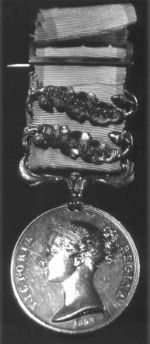
Crimea obverse
|
The war with Russia came about for a number of reasons, but perhaps the most over-riding reason from the British point of view was the need to contain Russia within her boundaries and to prevent her expanding into Turkey, then known as "The sick man of Europe". On 28th May 1854, Britain and France declared war on Russia; they were joined later by Sardinia.
The epic gallantry and extreme suffering of the troops during the campaign are part and parcel of our history. That very history that we have allowed to diminish in our schools, to be replaced by "modern history"! Many are the deeds of outstanding bravery and devotion to duty. The charge of the Light Brigade under Lord Cardigan, the Charge of the Heavy Brigade under General Scarlet. "The Thin Red Line" of the 93rd Highlander's under Sir Colin Campbell, whom we shall be hearing more of later; and of course Florence Nightingale, are but a few.
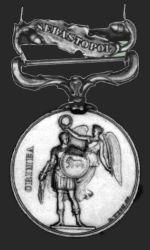
Crimea reverse
|
The Army were led by many Generals whose last active service had been under Wellington in the Napoleonic wars. It is recorded that Lord Raglan the Commander in Chief often referred, unthinkingly, to the French as "The enemy". Queen Victoria was so stirred by the deeds performed by her Army and Navy in the Crimea that she directed that a medal be issued in 1854, with clasps for Alma and Inkermann. Clasps for Balaclava and Sebastopol were not sanctioned until the following year.
The obverse shows the diademed head of Queen Victoria with the date 1854 underneath and the legend Victoria Regina designed by W. Wyon. The reverse shows a Roman warrior holding a sword in his right hand and a circular shield in front of him with his left whilst being crowned by a small winged figure of Victory with the word Crimea written vertically on the left. The ribbon is light blue with yellow edges. The medals were issued unnamed, but could be returned for naming free of charge. Those that were officially named were done in indented square or engraved capitals. As Peel had died by the time the Crimea medal was issued it was never returned for naming.
continued on page 4 ...





 William Peel, Captain, throwing a live shell over the parapet.
William Peel, Captain, throwing a live shell over the parapet.
